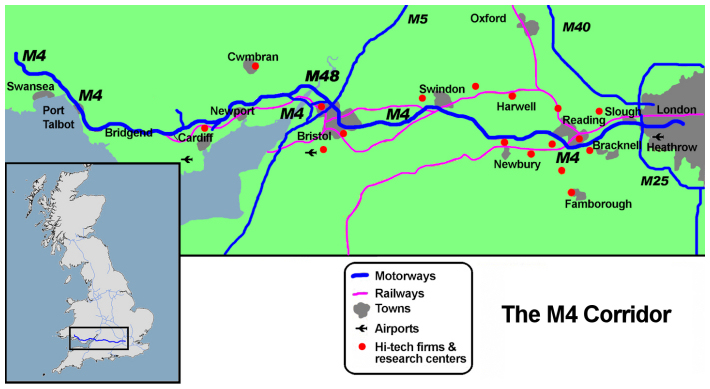The corridor is a narrow belt of land that has become home
to a growing number of services and high-tech industries. It is sometimes
described as England's Silicon Valley. It's spine is provided by the M4
motorway, which stretches westwards from London, along the main railway line to
Bristol and Cardiff. It contains a number of well-established cities and towns
with significant manufacturing such as Reading with the 3 b's (beer, biscuits
and bulbs) and Cardiff is another port once famous for the export of coal, iron
and steel but now the home of Welsh Assembly. However, those old industries
have now largely disappeared and been replaced with newcomers. Some of those
that have disappeared and have been replaced with newcomers. Some of those that
have disappeared and have been replaced by newcomers. Some have resurfaced in
other countries. In the second half of the 20th century the character of the
corridor began to change. There was a considerable growth in population because
commuters and their families moved out of London in search of cheaper and
better housing. The M4 motorway was opened and the main railway line was
upgraded. New factories appeared, many of them associated with food and drink.
Other involve cars, electrical and other household goods. However, most
conspicuous among the new industrial enterprises were so called high-tech
industries. Such as Compaq, NEC and Intel are here (in the quaternary sector). Reading
for example, has become home to a mix of businesses that include Microsoft, ING
Direct, Prudential and Ericsson.
What factors have encouraged this concentration of high-tech
industries?:
•Transport and accessibility- the presence of
Heathrow is an important factor. The nature of much high-tech activity is
essentially international. Both staff and products have to move around the
globe quickly and often on short notice.
•Labour- suitably qualified and experienced workers
enjoyed large salaries. They can afford to choose where they live. The corridor
is able to offer many attractive residential locations.
•universities- many of the companies in the corridor
are involved in research and development for the reason 'feed off' links with
universities and establishments. The corridor contains at least 3 universities
with high research rankings -Reading, Bristol and Cardiff. Not far outside the
corridor to the North is Oxford University.
•Incentives- firms have been encouraged to set up by
various incentives offered by local government authorities, the UK government
and EU. The incentives include earmarked Greenfield sites at reduced prices and
with tax exemptions.

No comments:
Post a Comment